
BREAK MY BODY, LIBERATE MY SOUL by Ankita D. '23
a student-made installation in the Stata Center R&D pub
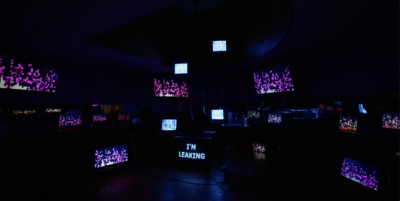
in the heart of the Frank Gehry-designed Stata Center, the icon of architecture of MIT’s campus, lies a pub. it opened in 2004 and was used for at least a decade, but has since been abandoned for wayfaring students to stumble across. in my time, I’ve heard it being used for parties, scavenger hunts, and the like, which is why I was fascinated to hear that one of my good friends, Karyn Nakamura ’23, was repurposing it for an immersive installation. a complex installation that would take several months to build, no less.
the project, which Karyn refers to as a “20-channel Frankenstein video organism,” is composed of E-waste scavenged from campus storage closets01 such as the Theater Arts tech closet, which has a ton of obsolete equipment that is gathering dust and dumpsters.02 specifically, the Stata loading docks, an e-waste and recycling pick up spot where you can find a variety of abandoned technological items woven into the network are 20 digital monitors, glass tanks hanging from 20 feet above ground, and an endless mass of cables, exposed wires, and tubes. the ‘organism’ extends its limbs throughout the space, and its body, amalgamated from years of broken garbage, serves as a vessel for communication.
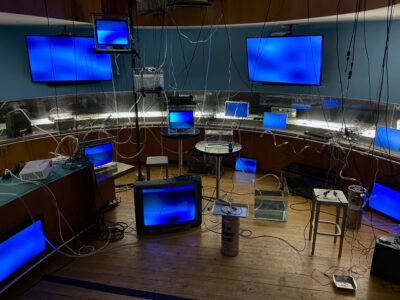
Karyn’s performance, titled Break My Body, Liberate My Soul, is about an hour long and consists of multiple scenes of varying lengths. it begins with Karyn moving through the room, connecting wires, filling glasses of water, and pressing buttons that gradually seem to rouse the system. once it fully comes alive, all the screens turn red and it launches into a gripping and ominous glitch sequence that displays the words “coursing through your body and soul.” the scene, which is coupled with a jagged electronic sound, perfectly sets the tone for the frenetic visuals that are to come.
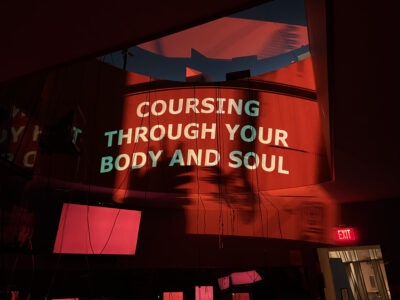
as the scenes unfold, you struggle to discern what is happening in front of you, but feel yourself being immersed in the space more and more. one sequence features footage of people eating, working, and talking within the Stata Center, which is an interesting interaction with the very building harboring the organism. in another scene, water starts dripping from above into a wine glass on the ground holding two ends of cable, thus completing the circuit; later, Karyn fully submerges herself in a glass tank.
there are countless elements to the installation that I couldn’t detect even after two watches. with everything going on—the music, the sound of dripping water, the humming of the machine, and the intense flashing from screen to screen—it becomes difficult to process what you’re experiencing. when the show ends, you’re left with feelings of awe, wonder, and overwhelming confusion.
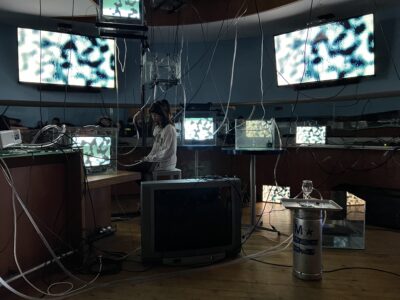
Karyn planned the installation over the summer, before she even knew she’d be able to use the R&D pub. for the first time in her artistic history, she spent a lot of time developing the concept, then found songs she wanted to use and decided what footage would pair with the sound. she didn’t have a complete idea of how the organism would manifest, but knew she wanted to work with electronic signal and to understand technology through emotion and intuition. she had been thinking about noise and signal and the subjectivity of defining the two, and she felt strongly about the ability of video to communicate beyond language, which she had picked up from obsessively scouring the internet for all kinds of video art.
after formulating a concrete idea of what she wanted, Karyn switched to execution mode, which marked the beginning of a lot of fighting. she knew she wanted a permanent space to work in, as opposed to the classrooms she had previously used where she would have to clean up her equipment before class. the Stata R&D pub, on the other hand, was an unused—and very fucking cool—space for her to leave dozens of monitors and cables lying around. Karyn found the pub a year ago, and when she was thinking about potential spaces she could use for her project this fall, it immediately came to mind.
the next step was figuring out how to get permission. this entailed endless email chains with multiple branches of staff and admin to explain the unconventional project. Karyn first reached out to the director of CSAIL and MIT Dining, who welcomed the project since they knew about her previous large-scale work. the project ultimately went through an extensive safety process that involved it becoming an official Campus Construction Project stamped by external engineers. it was a lot, but Karyn is thankful for the team of staff and admin who worked with her to preserve her vision and ensure safety.
part of the approval process was envisioning the details of the space and the physical structures that would hold everything together. although Karyn was unfamiliar with what a feasible structure entailed, her instructor from the Theater Department, Josh Higgason, consistently reassured her that everything she wanted to do was possible. he was the one to make her model a reality, putting the scaffolding together and making the glass tanks hang from the ceiling.
the development process was uncertain; Karyn had no idea how to put together scaffolding or how to suspend 80 pound tanks, whether she would have enough CRTs and monitors, and if it would even be possible to distribute signal to the 20 screens with limited hardware and budget. thankfully, she ended up receiving a $5K grant from CAMIT03 ”Council to create the installation, most of which went into the glass tanks. in contrast, she spent $600 on electronics—$400 on a mini PC, and $200 on a video splitter. everything else came from equipment she found in the Theater Arts tech closet and Stata loading docks, from which she collected 63 screens total (on one day alone she acquired a batch of 15 Dell monitors).
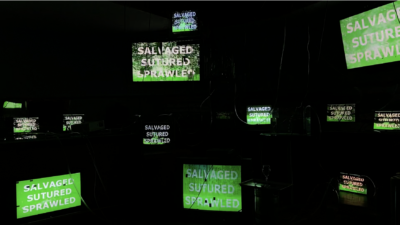
Karyn describes the entire process as “a semester of wrangling and fighting” with technology, rules, and herself. making the video content, the structure, and the signal distribution system all involved pushing the limit of what was possible and advisable. the result is nonsensical and magnificent, inspiring discomfort, reflection, and introspection. many people struggle to find their response to the performance, and many wouldn’t find it to be palatable or even approachable, but I find it to be a fascinating reflection of herself through the body of a complex machine. she finds a compelling balance between intention and randomness, which is an incredible feat.
my favorite part of the performance epitomized this. this scene, the final one in the show, is a frenzied, glitchy sequence of footage and animation synchronized with the song Moanin’ by Charles Mingus. I thought it was a perfect way to conclude; the music builds up into an epic climax as one of the bottom monitors displays “I’M LEAKING” and chaotic images ricochet between the other screens. Karyn told me she spent a full month on this scene, at times spending a full day on just one second. it definitely shows.
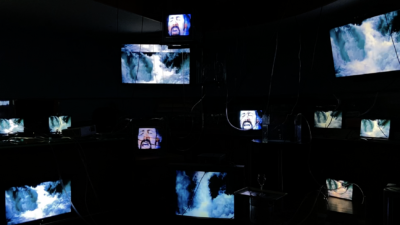
Karyn’s ability to compose and sequence glitch is masterful. the project is truly the culmination of her experience trying to be creative at MIT—spending a summer working with light and projection in W9704 the theater arts building helped her become familiar with the technology, understand the tactics employed in cultivating a visually powerful experience, and develop a practice of experimenting with wherever her intuition takes her. she owes this to Josh, who trusted her with access to space and equipment from the very beginning. also, since she spent almost the entirety of her fall semester in the pub, she had a lot of time to think about what works well in the space that she miraculously ended up having full reign over.
I think the installation is phenomenal, but Karyn asserts that she’s only 70% satisfied, attributing this to the fact that she has moved onto different ideas, as well as the fact that her personal experience of what was packed in the hour-long show was a five month long struggle. such is the inevitable nature of artistic creation, I guess.
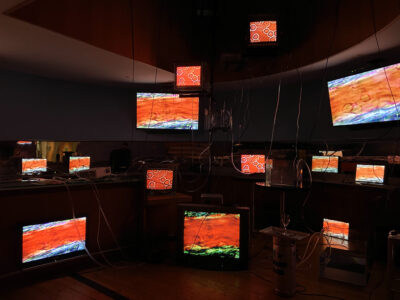
Break My Body, Liberate My Soul is a fascinating installation on multiple dimensions. there’s the irony of bringing scavenged analog tech into Stata, which is home to the most cutting-edge AI research on campus. there’s also the fact that that Karyn’s academic experience as a Course 4-B (Art and Design) has been nothing but an uphill battle; she has found it difficult to fully engage with classes in the architecture department due to their focus on utility and problem-solving. parameters are rigid, and you’re graded based on how well you can adhere to them. Karyn stated that many of her instructors have a strict curriculum that they want to impress upon students; moreover, they aren’t interested in learning about her as a person, so she’s had a hard time introducing herself and her ideas. in light of the fundamental and unbridgeable gap between the art she wants to do and the art Course 4 tries to make her do, her R&D installation is a triumph.
while Karyn has expressed discontent with architecture classes, she has enjoyed Art, Culture, and Technology (ACT) classes, as well her interactions with the Theater Department. she said these classes and the community she has found in the small bubbles of art at the school have really helped her “continue in the demoralizing fight that is trying to be creative at MIT.” fighting to do what she wants in Architecture classes is tiring, so it’s reassuring to have the liberty to create on her own terms.
Karyn is a remarkable individual and it makes sense that design instructors don’t know how to deal with someone so unique. most students take design classes casually05 as their one humanities arts requirement and aren’t so firm in what their interests are, so it’s difficult to accommodate both those who require structure and those who want to be left alone
it’s unfortunate that Karyn has experienced a wall between herself and most Course 4 instructors she’s had. she expressed that she feels like she can only be creative to a certain extent, and doing art involves a lot of fighting. however, this fighting opens doors to building relationships and trust with the few people who will give you a chance.
while Karyn has run into walls and felt discouraged at times, she is extremely grateful for the support she has found here. without her instructor Josh, she wouldn’t have been able to obtain all her video gear, or make her pub design a reality, or suspend TVs 20 feet in the air. MIT Dining, Campus Planning, Campus Construction, and Facilities helped her use the space and ensure the safety of the project, and the Theater Arts Department gave her the resources to make it possible. she also thanks all her friends and instructors who believed in her throughout the painstaking semester-long process.
Break My Body, Liberate My Soul is testament to the fact that there are still ways for students to find holes in structures that only seem to become more rigid, exercise the autonomy that they deserve, and to express themselves in the ways that they want. in the past few decades, a lot of restrictions have been levied against the student body, so it’s reassuring to see students finding the means to make their ideas possible, especially when they’re as large-scale as this.
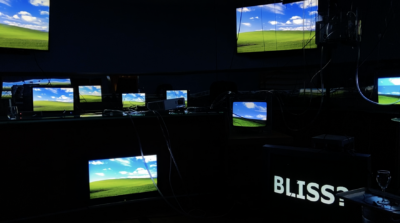
I’m happy to have had two opportunities to witness the ‘Frankenstein video organism’ come alive, and I wish more students could get a chance to see it. sadly, Karyn is taking down the installation in April, but you can still check out her other work here and her Instagram here!
- such as the Theater Arts tech closet, which has a ton of obsolete equipment that is gathering dust back to text ↑
- specifically, the Stata loading docks, an e-waste and recycling pick up spot where you can find a variety of abandoned technological items back to text ↑
- ��Council for the Arts at MIT” back to text ↑
- the theater arts building back to text ↑
- as their one humanities arts requirement back to text ↑